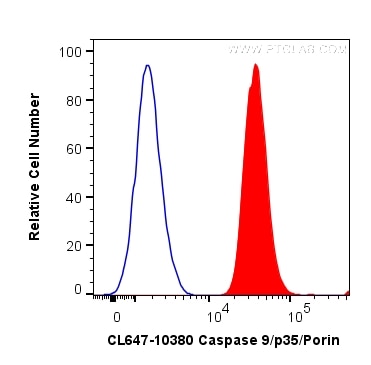Anticorps Polyclonal de lapin anti-Caspase 9/p35/p10
Caspase 9/p35/p10 Polyclonal Antibody for FC (Intra)
Hôte / Isotype
Lapin / IgG
Réactivité testée
Humain, rat, souris
Applications
FC (Intra)
Conjugaison
CoraLite® Plus 647 Fluorescent Dye
N° de cat : CL647-10380
Synonymes
Galerie de données de validation
Applications testées
| Résultats positifs en cytométrie | cellules HepG2 |
Dilution recommandée
| Application | Dilution |
|---|---|
| Flow Cytometry (FC) | FC : 0.20 ug per 10^6 cells in a 100 µl suspension |
| It is recommended that this reagent should be titrated in each testing system to obtain optimal results. | |
| Sample-dependent, check data in validation data gallery | |
Informations sur le produit
CL647-10380 cible Caspase 9/p35/p10 dans les applications de FC (Intra) et montre une réactivité avec des échantillons Humain, rat, souris
| Réactivité | Humain, rat, souris |
| Hôte / Isotype | Lapin / IgG |
| Clonalité | Polyclonal |
| Type | Anticorps |
| Immunogène | Caspase 9/p35/p10 Protéine recombinante Ag0404 |
| Nom complet | caspase 9, apoptosis-related cysteine peptidase |
| Masse moléculaire calculée | 46 kDa |
| Poids moléculaire observé | 46 kDa, 35 kDa |
| Numéro d’acquisition GenBank | BC002452 |
| Symbole du gène | CASP9 |
| Identification du gène (NCBI) | 842 |
| Conjugaison | CoraLite® Plus 647 Fluorescent Dye |
| Excitation/Emission maxima wavelengths | 654 nm / 674 nm |
| Forme | Liquide |
| Méthode de purification | Purification par affinité contre l'antigène |
| Tampon de stockage | PBS avec glycérol à 50 %, Proclin300 à 0,05 % et BSA à 0,5 %, pH 7,3. |
| Conditions de stockage | Stocker à -20 °C. Éviter toute exposition à la lumière. Stable pendant un an après l'expédition. L'aliquotage n'est pas nécessaire pour le stockage à -20oC Les 20ul contiennent 0,1% de BSA. |
Informations générales
Caspase 9, apoptosis-related cysteine protease (CASP9, synonyms: MCH6, APAF3, APAF-3, ICE-LAP6, CASPASE-9c)is a member of the cysteine-aspartic acid protease (caspase) family. Sequential activation of caspases plays a central role in the execution-phase of cell apoptosis. Caspases exist as inactive proenzymes which undergo proteolytic processing at conserved aspartic residues to produce 2 subunits, large and small, that dimerize to form the active enzyme. Caspase 9 is processed by APAF1; this step is thought to be one of the earliest in the caspase activation cascade. 10380-1-AP can recognize the pre- and cleaved- caspase 9. In recent years, the localization of caspase9 was a focus of interest. Beside its cytoplasmic distribution, a very extensive localization study was done on rat brain tissue, where caspase9 was found located predominantly in the nucleus and to a lesser extend in the cytoplasm [PMID: 15541731].
Protocole
| Product Specific Protocols | |
|---|---|
| FC protocol for CL Plus 647 Caspase 9/p35/p10 antibody CL647-10380 | Download protocol |
| Standard Protocols | |
|---|---|
| Click here to view our Standard Protocols |


